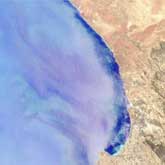Beware -- Red Tide!
 Red tides occur in oceans. They are not caused by herbicides or pollutants, but by a microscopic alga. Karenia brevis, when in higher than normal concentrations, causes a red tide. This bacterium actually produces toxins within its body, which cause fish to become paralyzed and die. This results in large fish kills on many shorelines. So, why is it called 'red tide'? Well, large blooms or colonies of the algae give off a reddish appearance in the ocean.
Red tides occur in oceans. They are not caused by herbicides or pollutants, but by a microscopic alga. Karenia brevis, when in higher than normal concentrations, causes a red tide. This bacterium actually produces toxins within its body, which cause fish to become paralyzed and die. This results in large fish kills on many shorelines. So, why is it called 'red tide'? Well, large blooms or colonies of the algae give off a reddish appearance in the ocean.
Red tides are naturally occurring events. Nothing that humans do can help or stop the red tides. Winds can wash the blooms up on shore leading to the tides. Most red tides occur between August and February. A certain set of environmental conditions must be met to have a red tide. These conditions are not well understood.
Red tides can affect more than just fish. People in the water during a red tide can experience allergy-like symptoms such as eye and throat irritation. When boat propellers send the microscopic algae into the air, they can be breathed in by people on the shoreline, causing the same symptoms. These are known to appear within 24 hours. Filter feeding shellfish, such as oysters, are not affected by the red tides and can be readily eaten. Fish exposed to red tide die from the toxin in Karenia brevis and should not be eaten.
About the Author
Rebekah Shaffer
 Rebekah Shaffer is currently a Junior at Slippery Rock University, PA. She is pursuing her B.S. in Biology, minor in Chemistry. She currently works as a microbiology lab assistant at Slippery Rock University and is a member of Beta Beta Beta Biology Honorary Society. She plans to obtain her Ph.D. in Molecular/Cellular Biology after completing her undergraduate degree.
Rebekah Shaffer is currently a Junior at Slippery Rock University, PA. She is pursuing her B.S. in Biology, minor in Chemistry. She currently works as a microbiology lab assistant at Slippery Rock University and is a member of Beta Beta Beta Biology Honorary Society. She plans to obtain her Ph.D. in Molecular/Cellular Biology after completing her undergraduate degree.


